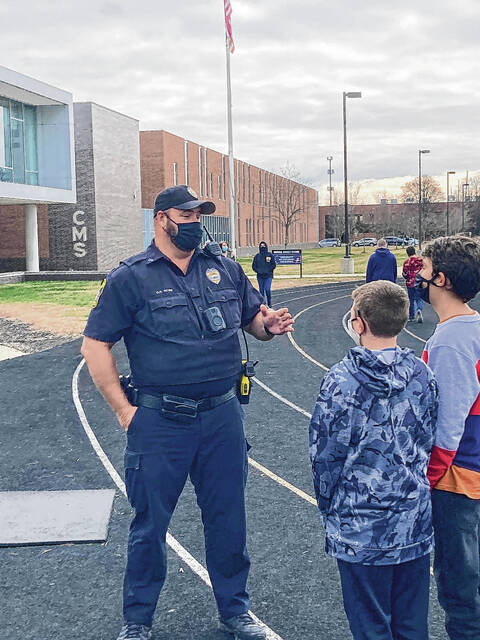
Photo provided BCSC School Resource Officer Greg Ross speaks to Central Middle School students.
Photo provided
Bartholomew Consolidated School Corp. school resource officers were faced with a multitude of challenges in the first nine weeks of this school year.
A student fell through a glass window and suffered life-threatening injuries.
A local high school was put on lockout after a teenager made nonspecific threats of gun violence on social media.
Another school was evacuated due to a bomb threat — one where the device in question was actually a portable charging device, according to officers.
A teenage girl was killed in a hit-and-run as she crossed the street to get on a school bus.
In each of these incidents, local school resource officers responded to the scene.
“This semester has been the busiest one that we’ve experienced since the SRO Program began in 2014,” wrote Sgt. Julie Quesenbery in her first quarter report to BCSC school board members.
“The call types were much more pressing and severe in nature.”
Incidents went up from 45 to 60 in the first quarter, while one-on-one contacts “went down significantly but is still holding at a solid 306.” In Quesenbery’s opinion, the latter decline is due to major events that took place during this timeframe and “resulted in time being spent (by school resource officer) in other areas.” School visits were up from 234 to 252.
In addition to the incidents mentioned above, there were other complicated issues school resource officers handled.
Two students at Central Middle School were able to shut down the BCSC server by “overloading it with data,” the school resource officers reported. Their actions prevented students and staff from doing daily tasks requiring computers, phones and the internet and also caused difficulties for Cummins, Inc.
There was also a gun threat at Columbus North High School that took a “significant amount of SRO time to investigate” and a report of a possible shootout at a restaurant near Northside Middle School.
When asked what the most challenging part of the first quarter was, Quesenbery replied, “Handling multiple big incidents at once with only five resource officers.” Handling these larger events meant that smaller incidents were often on the back burner, she said. They were able to respond to them, but it took some time.
“For a corporation of our size, we are vastly understaffed,” she said. “And so the biggest challenge was trying to be everywhere at once with only five people. … They (school resource officers) did a great job prioritizing and being where they needed to be. But that was by far the biggest challenge.”
Quesenbery cited the National Association of School Resource Officers, which recommends one “carefully selected, specially trained” school resource officer at every school.
“Previous thought has been to place one SRO per 1,000 students,” the organization recommends. “NASRO recommends considering factors such as campus size (including acreage and number of buildings), school climate and location, and the number of non-sworn safety team members on campus when determining the number of SROs needed on campus.”
BCSC has 18 school buildings, not including other facilities or Columbus Virtual Pathway. The school corporation has more than 11,000 students, according to recent average daily membership estimates.
In addition to major events, truancy and destruction of school property have also been issues, Quesenbery said. One trend of bathroom vandalism proved to be particularly troublesome.
“It was a TikTok challenge that kept us incredibly busy,” she said. “And it took up lots of time because it was happening in all of the buildings. … Five officers for 18 schools that we actually have students in, it’s incredibly busy. And then whenever you have students that are intentionally going in bathrooms for the purpose of messing up school property — that was a big time waste for us.”
The vandalism included taking soap dispensers, pulling sinks off walls, plugging toilets and sticking debris on walls — “really destructive” behavior, Quesenbery said. However, she added that, as of Nov. 17, they hadn’t seen any more of these incidents since returning from the first nine weeks.
A big part of the first quarter is that students were — and still are — readjusting to a new routine, she said.
“We have a lot more kids back in the building this year,” she said. “A lot of them are adjusting being in a building, especially the high school, for the first time. If you think about it, they haven’t had a normal year of school for a couple of years.”
Not all the issues school resource officers encountered were legal or criminal in nature, she said. Some were medical emergencies or safety-related incidents. Quesenbery wrote in her report that SROs completed “several home visits to check on students’ truancy and mental health.”
When asked if she thought the pandemic was related to some of the different problems she’s seen during the quarter, Quesenbery said, “Absolutely.”
A lot of students are dealing with social or emotional problems from learning at home, she said. Others have family members with substance abuse issues and may struggle with these issues themselves.
“Sometimes school is the safest place for kids,” Quesenbery said. “… That’s where their trusted adults are. So that makes it very difficult for students to have to be at home.”
Some students may also need to adjust to the presence of resource officers or familiarize themselves with new officers now that they’ve changed schools. Quesenbery said it’s important to “reaffirm what our job is there” — and what it isn’t.
“It’s a bad day when we have to get kids in trouble,” she said. “We don’t like to have to do that, but we do. We want to be there, of course, like I said earlier, to promote a safe environment and build relationships with kids. And we’re not trying to hunt kids down to see how much trouble we can get them in. Don’t get me wrong, we’ll deal with it every time and do so respectfully and kindly, but that is not our mission.”
“The second time someone’s caught in possession of a vape, they get a citation,” she said. “Then it goes to the prosecutor’s office.”
In looking at the second quarter overall, Quesenbery said that it’s been “steady” so far. However, she didn’t want to comment too soon, as it wasn’t over yet.
“We haven’t had, so far, the events that we had first semester,” she said. “So far.”
However, that isn’t to say the quarter has been completely uneventful. On Nov. 16, a male student at Schmitt Elementary was taken into custody by SROs after he was accused of punching two female students in an unprovoked incident.
“I’ve learned not to predict too much, over the years,” Quesenbery said, when asked about her predictions for the spring. “I’ve been at East High School since 2014 with this program, when it first started. … My hope is that kids continue to adjust to being in the buildings and making safe choices and following the rules of the building. So my hope is that they get further adjusted into being there and don’t feel so like a fish out of water.”
There are some staffing changes coming to the school resource officer program.
Quesenbery supervises the team and maintains a presence at Columbus East. Starting in January, Officer Eric Kapczynski will move from Northside to East.
“I will take on more of a supervisory role and go between buildings and be able to show up when the bigger things happen and be able to assist and supervise,” Quesenbery said, “rather than maintaining the second-biggest building in our district.”
She had to leave the school often to help with incidents, and it didn’t “feel good” to leave East without a school resource officer in the high school.
January will also see a new officer at Central Middle School, Bernard Sims. The current school resource officer at Central, Greg Ross, is returning to patrol, Quesenbery said, so Sims will be replacing him.
Ross was commended for his work at Central when he saw and detained a suspect with two concealed, loaded handguns on school property acting suspiciously around vehicles.
The middle school, 725 Seventh St., in downtown Columbus, is located in the area of the Bartholomew County Library, CSA Lincoln and St. Peter’s Lutheran School. Central had about 650 students in the building the day of the incident, with CSA Lincoln at about 280 students in the building, school officials said.
Quesenbery told school board members while this school year has been challenging, the school resource officers have responded admirably.
“I could not be more proud of their efforts and enthusiasm for guiding, working with and protecting the students and staff in our buildings,” Quesenbery said.
“Just being one of the caring adults in a building, we know that contributes to a child’s success,” she said. “… Those officers, they really put out some effort into being that person.”




